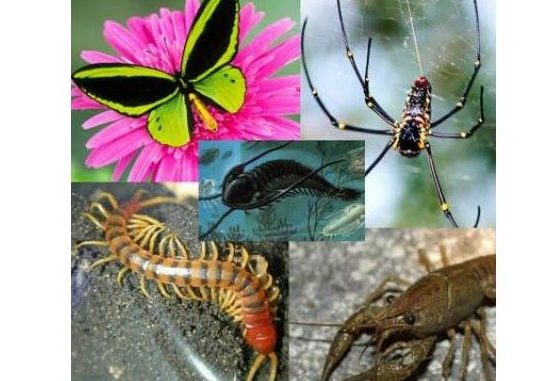
Salient features:
- Phylum Arthropoda is the largest group of the animal kingdom, surpasses all others both in number and ecological diversity of organisms.
- They are mostly terrestrial but few are aquatic forms.
- They are bilaterally symmetrical, metamerically segmented Their metamers are not alike but tare specialized and their number is generally fixed.
- They have jointed appendages with variable function.
- Exoskeleton is made up of chitinous cuticle that is shed at intervals. The process of casting off the skin or integument is known as ecdysis or moulting.
- Body is divisible into head, thorax and abdomen in Insecta whereas into cephalothorax (head+ thorax) and abdomen in Crustacea and Arachnida.
- Tube within a tube body plan is present.
- Alimentary canal is complete which consists of foregut, midgut and hindgut.
- Mouth parts are adapted for various modes of feeding (biting, cutting, chewing, sucking and piercing etc.) and hepatopancreatic gland is present.
- Circulatory system is open type, with a dorsal heart, arteries and blood sinus.
- The blood is colorless and contains WBC only.
- The body cavity is full of haemolymph (blood). They are haemocoeloate, i.e. the true coelom is restricted to gonads.
- Respiration takes place through general body surface or gills in crustaceans, through trachea in insects and Myriapoda, through book lungs in Arachnida and book gills in king
- Excretion is brought about by green glands in aquatic forms and malphighian tubules or coxal gland in terrestrial arthropods.
- Aquatic arthropods are ammonotelic whereas terrestrial forms are uicotelic.
- Central nervous system is composed of paired preoral ganglia connected by commisures to a ventral nerve cord. The ventral nerve cord is double, solid with segmental ganglia and nerves.
- Sense organs comprise of simple or compound eyes, antennae, chemoreceptor, statacyst
- Unit of simple eye is called ocelli and of compound eyes is called ommatidia. Vision is mosaic.
- Sexes are separate and are oviparous animals.
- Fertilization is internal with direct or indirect development.
Classification:
Phylum Arthropoda is divided into seven classes but modern classification includes Chilopoda and Diplopoda under a single class called Myriapoda.
Class: Onychophora
- It is a connecting link between annelids and arthropods and are mostly terrestrial.
- Body is without external segmentation.
- Annelidan characteristics:
- The integument is thin, soft and without exoskeleton.
- Parapodia like appendages are present which are unjointed.
- Excretory organs are nephridia.
- Arthropodan characteristics:
- Tracheal gills are present for respiration.
- Appendages terminate into claws.
- They have salivary gland and their coelom is reduced.
- Head has a pair of simple eyes, a pair of antennae, a pair of oral papillae and a pair of jaws.
- e.g. Peripatus
Class: Crustacea
- Chitinous cuticle covers the body which is divisible into cephalothorax and abdomen.
- Cephalothorax is covered by a carapace which bears spiny rostrum.
- A cephalothorax bear two pairs of antennae, two pairs of maxillae, one pair of mandibles, generally a median eye and a pair of compound eyes.
- They are ammonotelic and excretion is by green glands or antennary gland.
- The appendages are modified for swimming, respiration and reproduction.
- Respiration is carried out either by body surface or by gills.
- Heart is arterial, i.e only oxygenated blood is present.
- Sexes are usually separate with sexual dimorphism.
- Development is indirect with Zoea larva.
- Most of them are edible, constitute the food for aquatic or terrestrial life.
- e.g. Palaemon (prawn), Cancer (crab)
Class: Myriapoda
- They are mostly terrestrial.
- Body is long and divisible into head and trunk.
- Head consists a pair of antennae, a pair of simple eyes and two to three pairs of jaws.
- Trunk consists of many segments with each segment having one to two pairs of legs.
- Respiration occurs with the help of trachea.
- Excretion takes place by malphighian tubules.
- Development is direct.
- e.g. Scolopendra (Centipede), Julus (Millipede)
Class: Insecta
- They are mostly terrestrial and rarely aquatic.
- Body is bilaterally symmetrical and segmented. It is divided into head, thorax and
- Head bears a pair of compound eyes, a pair of antennae and different types of mouth parts (chewing and biting, piercing and sucking).
- Thorax consists of three segments (prothorax, mesothorax and metathorax).
- Wings arise from meso- and metathorax while legs arise from each thoracic segment. Abdomen neither consists of legs nor wings.
- Respiration takes place by trachea or gills.
- Heart is tubular and divided into chambers (in cockroach- 13 chambered).
- Malphighian tubules help in excretion and are uricotelic.
- Sexes are separate.
- e.g. Periplaneta (Cockroach), Butterfly, Mantis, Housefly etc.
Class: Merostomata
- They are exclusively marine forms.
- Body is divided into prosoma (cephalothorax) and opisthosoma (abdomen).
- Cephalothorax is covered by a carapace and bears a pair of simple eyes, a pair of large compound eyes, a pair of chelicerae, a pair of pedipalp (mouth parts) and five pairs of appendages (legs).
- The anus ends in a sharp telson.
- Respiration occurs by book gills and development is indirect.
- e.g. Limulus (King crab)
Class: Arachnida
- They are mostly terrestrial and rarely aquatic.
- Body is divisible into prosoma (cephalothorax) and opisthosoma (abdomena).
- Prosoma bears simple eyes, one pair of chelicerae, one pair of of pedipalp and four pairs of legs.
- Antennae and true jaws are absent. Opisthosoma is usually without appendages.
- Respiration takes place by book lungs.
- They are unisexual and usually without sexual dimorphism.
- Development is generally direct.
- e.g Aramea (Spider), Palamnaeus (Scorpion)